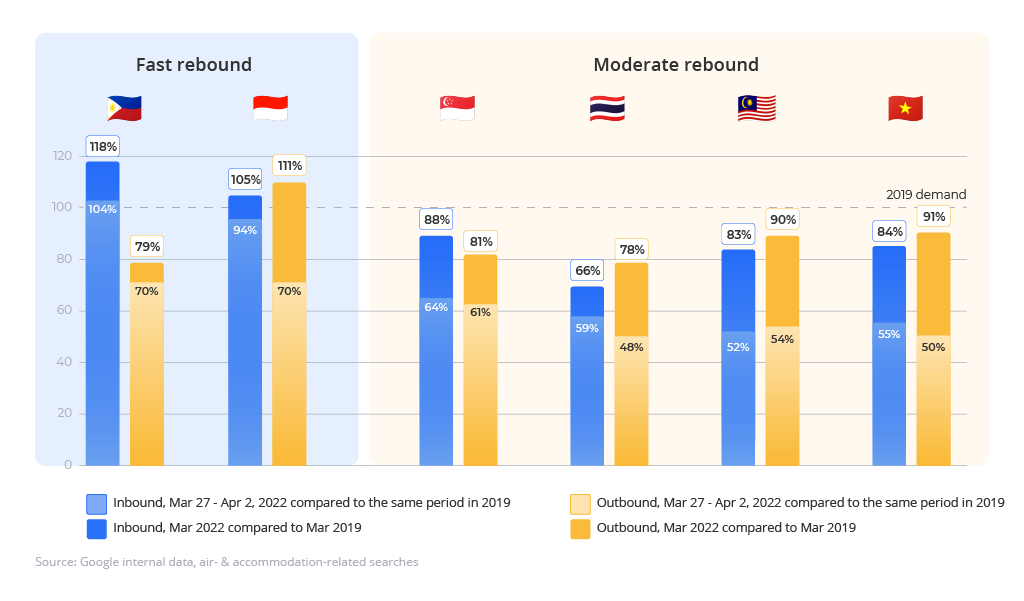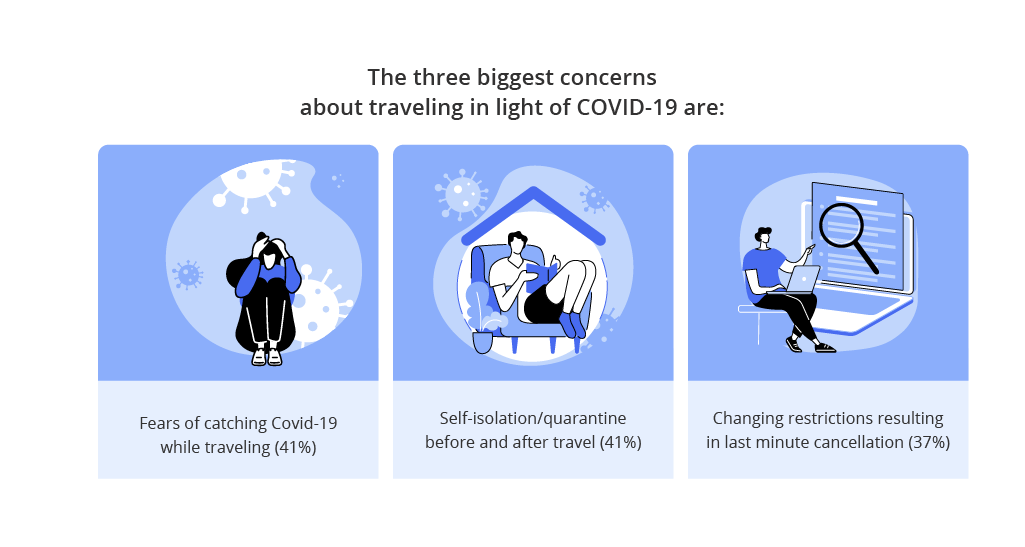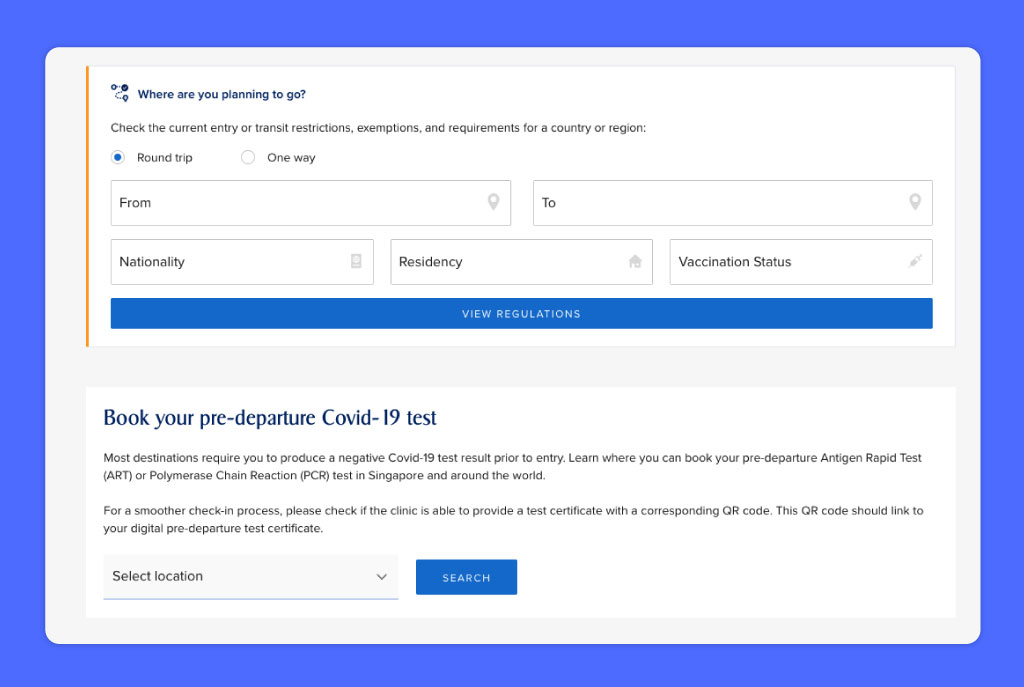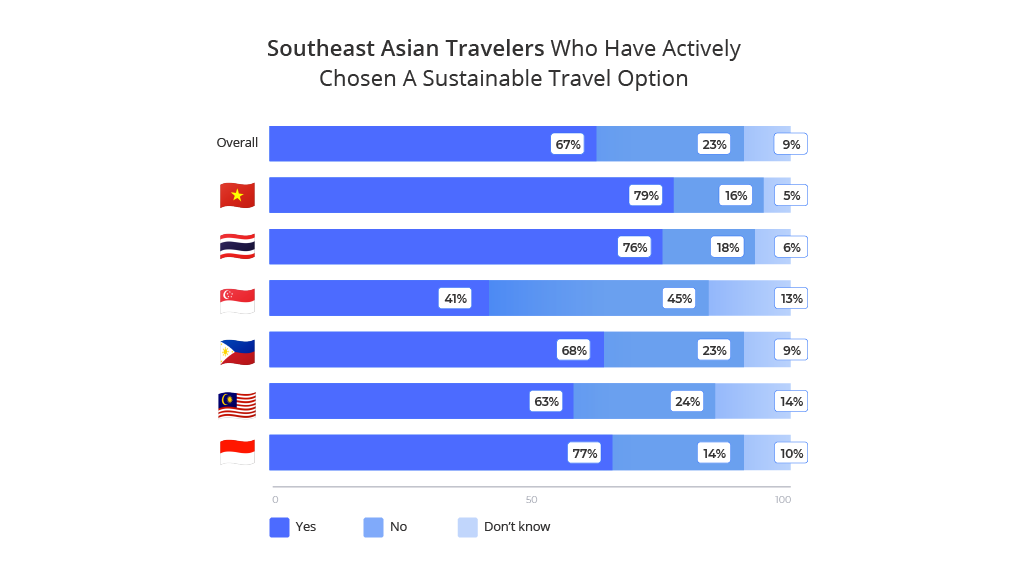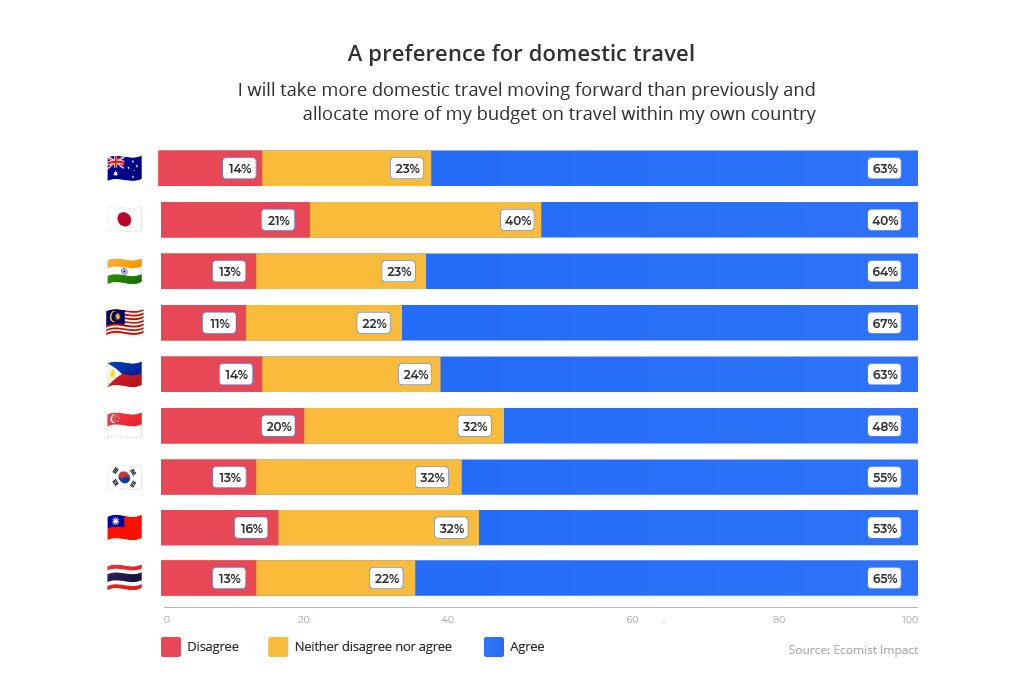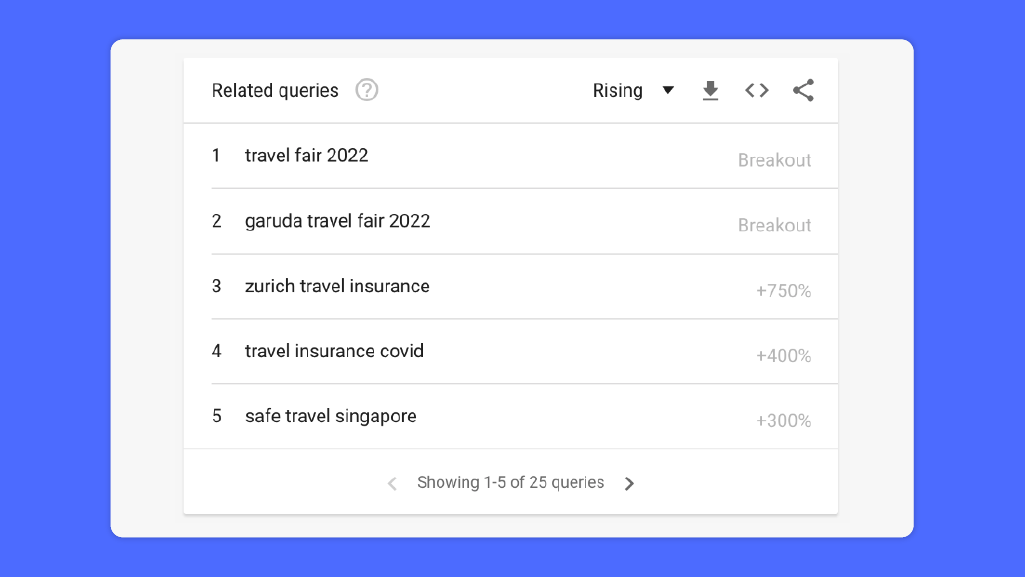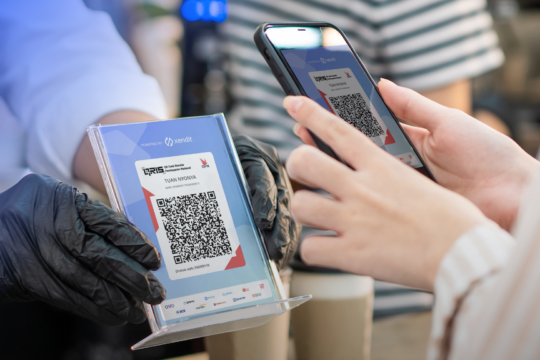2022 looks to continue being a year of recovery for the travel industry, as more and more countries relax Covid-19 restrictions. In this article, we will look deeper into the recovery–and how travel is changing. We’ll identify the top travel trends in 2022 and give recommendations on how players in the industry–airlines, booking platforms, hotels, and more–can capitalize on them and come out ahead.
Travel is rebounding in Southeast Asia
While Europe had already started lifting most restrictions in late 2021, and life is almost back to normal in places like the United States, countries in Asia have been much more conservative. However, even Hong Kong is relaxing some testing requirements for incoming passengers. Meanwhile, Japan opened up to foreign tour groups in June. Thailand has lifted restrictions on vaccinated tourists since May 2022.
Not only are countries keen on welcoming tourists back to their countries to boost their income, but travelers are equally excited to start traveling in 2022.
Google’s data on travel-related search volumes in Southeast Asia are promising. Inbound travel demand – visits by non-residents to a country – is growing the fastest in the Philippines and Indonesia.
#1 Blurring of work and play results in longer stays
One of the travel trends in 2022 that result directly from prolonged remote work during the pandemic is workations–work and vacation rolled into one.
As companies were forced to work remotely, many realized their employees could perform just as well, if not better, when working from home. Many employees love it too.
Why not take months-long workations? With the work-from-anywhere policy, you can spend 8 hours of your day working on your laptop in the comfort of your vacation rental or hotel, then spend your time off doing what you love. Maybe it’s surfing along the beautiful beaches in Bali. Maybe it’s taking day trips visiting world heritage sites in Cambodia.
If you work in the high-touch hospitality industry, this may seem far-fetched. But the truth is, the number of digital nomads is rising. 16% of companies worldwide are fully remote, with companies like Linkedin, Spotify, Dropbox, and more offering work-from-anywhere perks.
Corroborating this, the demand for longer-term rentals is skyrocketing. Google’s search volume data show that interest in vacation rentals among Southeast Asian travelers rose by a massive 1010% year on year.
In fact, the Indonesian government is already planning to capitalize on this opportunity. Tourism Minister Sandiaga Uno confirmed that a special five-year visa for remote workers, which will allow them to live in the country tax-free for that duration, is in the works.
Opportunities:
This has implications not only for vacation rental companies like Airbnb, but also for hotels, airlines, booking websites, and more:
- Discounted long-term rates: Hotels and vacation rentals can have promotions for long-term stays to lock in travelers for longer periods. For example, they can offer discounted rates by weeks and months instead of days. They may end up making less per day, but can gain a higher occupancy rate, lower customer acquisition costs, and be more profitable overall.
- Work-friendly amenities: Good Wi-Fi is a must for remote workers. Other than that, hotels and vacation rentals should also invest in amenities that facilitate comfortable long-term stays–a functioning kitchenette, laundry amenities, well-lit workspaces, and more.
- Tie-up promotions with long-term accommodations: Airlines and booking sites can offer sales targeting those with longer stays. They could also partner with hotels and rentals to offer irresistible accommodation add-ons. Tour organizers can organize recurring weekend activity packages to help these remote workers craft an unforgettable workation experience.
#2 Hybrid work opens up unconventional opportunities
The pandemic has also normalized hybrid work arrangements and flexible work models worldwide.
Not all companies follow the work-from-anywhere, or even work-from-home, model. But even those who insist on employees returning to the office often allow employees to work outside the office a few days every week.
Google, for example, is asking workers to be back in the office 3 days a week.
Around 62% of employees aged 22 to 65 say they work remotely at least occasionally.
While workers may not want to return to the office fully, not everybody has the most conducive environment at home. They may live in an overcrowded house with family members engaging in various activities. They may have disruptive children, or simply crave a change in environment.
This may not sound like travel per se. But it does open up opportunities for some players in the travel industry–namely hotels and their F&B establishments.
Opportunities:
Workers trying to avoid the noisy environment, and sometimes the suffocating heat of their homes will appreciate a nice, cool, cozy place to work at. Hotels still struggling to up their occupancy rates can offer working packages and allow room bookings during working hours.
Hotels and cafes can offer guests working packages to allow them to work at their space–perhaps with free-flow snacks, drinks, and most importantly, good Wi-Fi.
#3 Sanitization and easy availability of safety information are important
With year-on-year growth of over 165% in travel insurance-related searches in Singapore, Malaysia, and the Philippines, it’s safe to say that this is a prominent travel trend in 2022: travelers are getting more cautious.
Among travelers’ top concerns are catching Covid-19 during their trip (41%) and having to change plans due to travel restrictions (37%). Both of these can come with a hefty cost.
As a result, proper sanitization and easy availability of safety information are crucial factors to attract those traveling in 2022.
Opportunities:
This travel trend is something that companies all over the travel industry can capitalize on–insurance companies, airlines, booking sites, tourist attractions, hotels, restaurants, and more.
- Travel insurance with Covid-19 covers. Many countries require incoming travelers to be covered by travel insurance of a certain amount, including Covid-19 cover. Insurance companies can pair up with ticketing platforms and airlines to push their Covid-19 travel insurance that will help travelers fulfill the requirements of host countries.
To further reassure travelers, insurers can also provide useful—though non-essential–additional cover that lessens travelers’ worries about unexpected Covid-19-related situations. Some examples are being unable to fly after contracting Covid-19 while overseas, or trip cancellations due to relatives being diagnosed with Covid-19.
- Reassurances on sanitization quality and frequency. Frequently and regularly sanitizing surfaces in your facilities–and most importantly, communicating this with the customers—can help travelers feel safer. For example, you could display sanitization certificates by professional sanitization companies. Placing conveniently located hand sanitizer dispensers could be helpful, too.
- Handy resources to help comply with local regulations. Researching travel requirements can be confusing and time-consuming. Industry players, such as airlines, can reduce this friction. By helping prospective travelers have easier access to credible, updated information on Covid-19 specific restrictions, they can make it easier to go ahead with the booking.
Singapore Airlines, for example, has a one-stop Covid-19 Travel Advisories page where you only need to enter your destination, nationality, residency, and vaccination status, and all requirements applicable to you will be displayed on one page.
- Self-serve facilities that reduce human contact. Singapore’s Changi airport, for example, has implemented innovations to lower the spread of Covid-19. A few examples are the functionality to book check-in and pre-boarding screening slots online, contactless check-in, and contactless lift buttons.
- Automated and flexible cancellation policies. Making it easy to cancel or reschedule without incurring much additional cost (if any) would be a reassuring move that will nudge would-be travelers to go ahead and click that “Book Now” button. With automated cancellation policies, travelers know you’ve got their back. If something goes wrong because of Covid-19, they know that they’re not risking their hard-earned money.
- Contactless mobile payments. Bank notes and coins are constantly being passed from one person to another. They are held in hands that may possibly harbor the Covid-19 virus. One of the best ways to reduce human contact and hence reduce the spread of Covid-19 is by adopting contactless mobile payments.
With the skyrocketing adoption of digital payments in Southeast Asia, now’s a great time to integrate contactless payment methods.It’s easy to provide all these payment methods so customer can pay the way they prefer to. Companies in Indonesia and the Philippines can integrate with payment gateways like Xendit and gain access to 20+ payment methods with one integration.
According to our internal data from 1 Jun 2021 to 1 Jul 2022, the 5 most common payment methods (by transaction count) for processing payments in the Travel and Tourism sector are:
-
- Virtual accounts (>26%)
- QR Code (>25%)
- e-wallets (>20%)
- Retail outlets (over the counter) (>20%)
- Credit cards (>4%)
#4 Uneven travel resumption may affect recovery
Demand for travel is increasing, but not evenly across the industry.
Business travels are on the rise. 68% of global business travelers say they’re pushing to travel again for work and corporate travel spend will likely reach 55% by the end of 2022. But business travel is at least two years from reaching pre-pandemic spend.
After 2 years of remote working, people are realizing how much can be done without meeting face-to-face. It will take a lot more now for people to make a work trip than it did pre-pandemic. In fact, Bill Gates predicted that some 50% of business travel will go away permanently.
Business travels used to account for 12% of passengers, but contribute disproportionately to revenue—and up to 75% of profits on some flights. On the other hand, leisure travelers are much more price-sensitive and are likely to plan and book trips in advance. This eats away at airlines’ profits.
With business travel recovery in 2022 looking less rosy, airlines’ recovery could be at risk.
Opportunities:
Capturing the less price-sensitive travelers
Airlines need to develop “new skills” to increase profits from other travel segments. Instead of expecting to rely on business travelers to make up for the thin margins associated with leisure travelers, airlines can try to partner with other players in the industry—travel agents, booking sites, hotels, attractions—to capitalize on new travel trends that are less price-sensitive. Luxury and sustainability, which we will delve deeper into later in this article, are a few examples.
#5 More travelers are caring more about sustainability
Worldwide, more and more travelers are placing more importance on sustainable travel. The pandemic appears to have accelerated this travel trend in 2022. This is true even in Southeast Asia.
Almost 7 in 10 (67%) Southeast Asian consumers say they have actively chosen a more sustainable or environmentally friendly travel option. Meanwhile, 9 out of 10 (90%) Southeast Asians feel it is important to preserve the cultural and natural environment of a destination for the future.
This is according to a 2022 research by Blackbox surveying 4,600 travelers across six ASEAN countries: Indonesia, Malaysia, the Philippines, Singapore, Thailand, and Vietnam.
However, a number of barriers are keeping these travelers from making green choices. Lack of access and information appear to be the primary hindrances: 41% did not know such travel options were available, while 40% had no idea how to find access such travel options. (40%).
Opportunities:
Travelers want to travel sustainably, but it’s difficult for travelers to find out who are the sustainable companies they should make bookings from. Simply put, the solution is to tell your customers what you’re doing in terms of sustainability.
- Airlines can market their efforts on reducing emissions. Google Flights, for example, already lets you compare flights by emissions–allowing travelers to factor environmental sustainability into their choice. This could be something airlines can capitalize on to capture environmentally conscious travelers
- Booking platforms and online travel agents (OTAs) can highlight sustainable choices better. These companies can to present booking options for “greener” travel choices more effectively. For example, they can highlight the most sustainable flight routes and hotel choices.
- Hotels can do more to assure travelers of a luxurious but sustainable stay. Reduce water use by only replacing linens and towels when soiled. Reduce waste by using dispensers containing good quality soap and shampoo. Use more sustainable energy sources by installing solar panels. Most importantly, communicate your sustainability efforts to your prospective guests.
- Organize sustainable tours that give back to the community. Tour operators can do their due diligence to ensure travelers will be spending their money on helping genuine local communities and communicate this to would-be travelers. Homestays, buying local art, and engaging with local communities are some ways travelers can give back to the community.
#6 Increased demand for luxury travels by revenge travelers
Cooped up at home for the past 2 years, travelers have been itching to travel and wanting to make up for the lost time.
In fact, Expedia is calling 2022 the year of the GOAT, or the “greatest of all trips.” In a survey of 12,000 travelers in 12 countries, the company found that 65% of respondents are planning to “go big” on their next trip. For example, more than two in five (43%) Singapore travelers are more willing to treat themselves. This includes shopping sprees, dining at Michelin star restaurants, and staying at 5-star hotels.
Other than the conventional luxury we usually think of, revenge travelers are trying to make their travel experience count in other ways, too.
Travelers are interested in not just checking off their bucket lists. They also want to step out of their comfort zones and immerse themselves in destinations and cultures that are different from their own.
Aside from that, travelers are looking for a sense of contentment and mental well-being on their trips.
Opportunities:
- Hotels can promote luxury packages that also take into account providing immersion opportunities, mental well-being, and unique, once-in-a-lifetime activities
- Ticketing platforms and airlines can pair up with luxury hotels and other unique local attractions to promote irresistible discounted packages that will give travelers a bang for their buck while creating an unforgettable experience
#7 Increased popularity of domestic tourism and rural locations
57.6% of travelers across Asia Pacific intend to spend more on domestic travel, according to a recent Economist Impact survey. This sentiment is strong in Asia. 67% of Malaysians, 65% of Thai nationals, and 63% of Filipinos have this intention.
There are a few possible drivers for this:
- Price-consciousness due to the economic downturn during the pandemic. Prolonged lockdowns during the pandemic have caused economic devastation across some parts of society in Asia. While borders are opening and economies have recovered somewhat, economic uncertainty remains on the horizon. This may have led to people being more cautious about spending, at least in the short term. Domestic tourism, especially to areas that are conventionally less popular, is a good compromise. People get to travel but need to spend much less.
- Reducing the likelihood of getting stranded overseas. 41% of those surveyed in this study stated that self-isolation or quarantine before and after travel is holding them back from traveling.Although borders have been opening up, there are still Covid-19 restrictions. For example, travelers who test positive for Covid-19 are not allowed to board their flights. So, there’s always a risk that a traveler can get stranded overseas—away from family, incurring additional costs on hotel stays, and possibly having to incur living expenses in an expensive location for many more days than planned. Traveling domestically reduces this risk.
- Less crowd means a lower likelihood of catching Covid-19. Traveling to less popular rural locations means that travelers who are more worried about catching Covid-19 can avoid crowded places, where they are more likely to catch the virus.
Opportunities:
Industry players across the board must not neglect domestic attractions that were less popular pre-pandemic. This includes airlines, ticketing platforms, hotels, attractions, and more.
They can invest in promoting more of these areas–many of which casual travelers may not be aware of yet–as viable, desirable travel destinations. This will be a win for end customers, industry players, as well as locals in the area.
One opportunity industry players can tap into is travel fairs.
Alongside the increase in interest in travel in Indonesia, “travel fair 2022” is one of the top queries Indonesians are searching for, according to Google Trends.
Industry players can raise awareness of hidden gems among domestic destinations during these fairs. They could tap into co-marketing promotions with credit cards, e-wallets, and other payment providers to entice would-be travelers. As a bonus, it’s now also much more convenient to collect payments on the spot thanks to the increased usage of digital payments such as QRIS in offline events.
Travel in 2022: Boost revenue by going digital
With travel rebounding and the demands of travelers changing after living through over 2 years of pandemic restrictions, there are new opportunities for players in the travel industry to tap into in 2022 and beyond.
Meanwhile, the Covid-19 pandemic has not only changed travelers’ wants and needs. It has also accelerated the digitalization of the economy. Consumers around the world have aggressively adopted everything digital over the course of the pandemic–especially in Southeast Asia.
In the first year of the pandemic, the ASEAN region added 400 million new Internet users. 70% of the population is now online. The number of active mobile-wallet accounts among the ASEAN-5 + Vietnam countries is also forecast to grow more than threefold to about 440 million by 2025.
Companies–including those in the travel industry– need to provide a seamless digital payment experience or get left behind.
The good news is that there are easy and quick ways to do this without much upfront investment.
Payment gateways such as Xendit enables businesses to receive payments from dozens of payment methods with just one integration. Xendit, for example, has a network of 140+ banks and 20+ payment methods you can access.
Xendit also enables payment gateway integration with booking engines and popular website builders. This way, you can easily give prospective travelers a seamless payment experience that makes it easy for them to complete their travel booking transactions–with just a few clicks.


